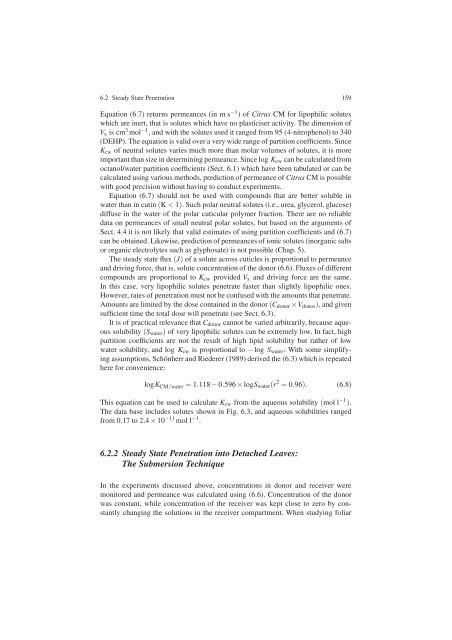Water and Solute Permeability of Plant Cuticles: Measurement and ...
Water and Solute Permeability of Plant Cuticles: Measurement and ...
Water and Solute Permeability of Plant Cuticles: Measurement and ...
Create successful ePaper yourself
Turn your PDF publications into a flip-book with our unique Google optimized e-Paper software.
6.2 Steady State Penetration 159<br />
Equation (6.7) returns permeances (in m s −1 ) <strong>of</strong> Citrus CM for lipophilic solutes<br />
which are inert, that is solutes which have no plasticiser activity. The dimension <strong>of</strong><br />
Vx is cm 3 mol −1 , <strong>and</strong> with the solutes used it ranged from 95 (4-nitrophenol) to 340<br />
(DEHP). The equation is valid over a very wide range <strong>of</strong> partition coefficients. Since<br />
Kcw <strong>of</strong> neutral solutes varies much more than molar volumes <strong>of</strong> solutes, it is more<br />
important than size in determining permeance. Since log Kcw can be calculated from<br />
octanol/water partition coefficients (Sect. 6.1) which have been tabulated or can be<br />
calculated using various methods, prediction <strong>of</strong> permeance <strong>of</strong> Citrus CM is possible<br />
with good precision without having to conduct experiments.<br />
Equation (6.7) should not be used with compounds that are better soluble in<br />
water than in cutin (K < 1). Such polar neutral solutes (i.e., urea, glycerol, glucose)<br />
diffuse in the water <strong>of</strong> the polar cuticular polymer fraction. There are no reliable<br />
data on permeances <strong>of</strong> small neutral polar solutes, but based on the arguments <strong>of</strong><br />
Sect. 4.4 it is not likely that valid estimates <strong>of</strong> using partition coefficients <strong>and</strong> (6.7)<br />
can be obtained. Likewise, prediction <strong>of</strong> permeances <strong>of</strong> ionic solutes (inorganic salts<br />
or organic electrolytes such as glyphosate) is not possible (Chap. 5).<br />
The steady state flux (J) <strong>of</strong> a solute across cuticles is proportional to permeance<br />
<strong>and</strong> driving force, that is, solute concentration <strong>of</strong> the donor (6.6). Fluxes <strong>of</strong> different<br />
compounds are proportional to Kcw provided Vx <strong>and</strong> driving force are the same.<br />
In this case, very lipophilic solutes penetrate faster than slightly lipophilic ones.<br />
However, rates <strong>of</strong> penetration must not be confused with the amounts that penetrate.<br />
Amounts are limited by the dose contained in the donor (Cdonor ×Vdonor), <strong>and</strong> given<br />
sufficient time the total dose will penetrate (see Sect. 6.3).<br />
It is <strong>of</strong> practical relevance that Cdonor cannot be varied arbitrarily, because aqueous<br />
solubility (Swater) <strong>of</strong> very lipophilic solutes can be extremely low. In fact, high<br />
partition coefficients are not the result <strong>of</strong> high lipid solubility but rather <strong>of</strong> low<br />
water solubility, <strong>and</strong> log Kcw is proportional to −log Swater. With some simplifying<br />
assumptions, Schönherr <strong>and</strong> Riederer (1989) derived the (6.3) which is repeated<br />
here for convenience:<br />
logK CM/water = 1.118 − 0.596 × logSwater(r 2 = 0.96). (6.8)<br />
This equation can be used to calculate Kcw from the aqueous solubility (mol l −1 ).<br />
The data base includes solutes shown in Fig. 6.3, <strong>and</strong> aqueous solubilities ranged<br />
from 0.17 to 2.4 × 10 −11 mol l −1 .<br />
6.2.2 Steady State Penetration into Detached Leaves:<br />
The Submersion Technique<br />
In the experiments discussed above, concentrations in donor <strong>and</strong> receiver were<br />
monitored <strong>and</strong> permeance was calculated using (6.6). Concentration <strong>of</strong> the donor<br />
was constant, while concentration <strong>of</strong> the receiver was kept close to zero by constantly<br />
changing the solutions in the receiver compartment. When studying foliar







